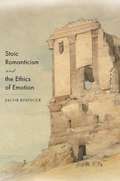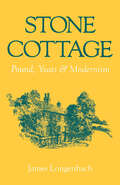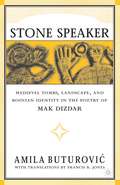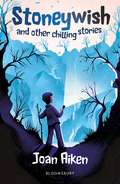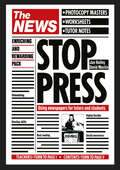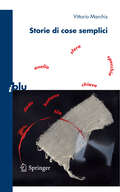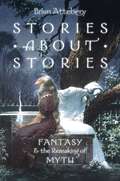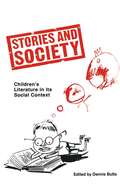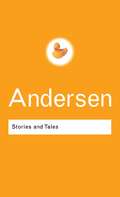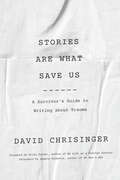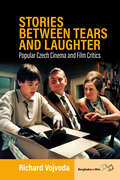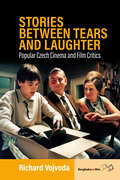- Table View
- List View
Stimulating Student Interest in Language Learning: Theory, Research and Practice
by Tan Bee TinThis book explores the issues and concerns many language teachers have in not just helping able students to learn a foreign or second language but more importantly how to get reluctant learners to become interested in language learning. Tin proposes ‘interest’ as an important construct that requires investigation if we are to understand second language learning experiences in a modern globalised world. The book offers both theoretical explorations and empirical findings arising from the author’s own research in the field. Chapters demonstrate how various theoretical and empirical findings can be applied to practice so as to raise the awareness of the importance of interest in language learning and teaching. For teacher trainers and educators, researchers, and practising language teachers, this comprehensive study provides tools to stimulate student interest in language learning for successful language learning.
Stock Characters Speaking: Eight Libanian Declamations Introduced and Translated
by Robert PenellaDeclamations were composed and orally delivered in the Roman Empire by sophists, or teachers of rhetoric, of whom the Greek-speaking Libanius was one of the most distinguished. Stock Characters Speaking may be thought of as emerging from three developments of recent decades: an explosive interest in late antiquity, a newly sympathetic interest in rhetoric (including ancient declamation), and a desire to bring Libanius’s massive corpus into English and other modern languages. In this book, author Robert J. Penella translates eight of Libanius’s declamations: 29, 30, 34, 35, 37, 45, 46, 47, and, in an appendix, the thirteenth-century Gregory of Cyprus’s response to Declamation 34. Each translation is accompanied by an introduction, in which Penella examines the themes, structure, and the stasis, or key issue, of the declamations. Figures who appear in the translated declamations include a parasite who has lost his patron, a man envious of his rich neighbor, a miser’s son, a poor man willing to die for his city, a rich war-hero accused of aiming at tyranny, and a convict asking for exile. Three of these declamations have appeared in German; otherwise, these translations are the first into a modern language.
Stoic Romanticism and the Ethics of Emotion
by Jacob RisingerAn exploration of Stoicism’s central role in British and American writing of the Romantic periodStoic philosophers and Romantic writers might seem to have nothing in common: the ancient Stoics championed the elimination of emotion, and Romantic writers made a bold new case for expression, adopting “powerful feeling” as the bedrock of poetry. Stoic Romanticism and the Ethics of Emotion refutes this notion by demonstrating that Romantic-era writers devoted a surprising amount of attention to Stoicism and its dispassionate mandate. Jacob Risinger explores the subterranean but vital life of Stoic philosophy in British and American Romanticism, from William Wordsworth to Ralph Waldo Emerson. He shows that the Romantic era—the period most polemically invested in emotion as art’s mainspring—was also captivated by the Stoic idea that aesthetic and ethical judgment demanded the transcendence of emotion.Risinger argues that Stoicism was a central preoccupation in a world destabilized by the French Revolution. Creating a space for the skeptical evaluation of feeling and affect, Stoicism became the subject of poetic reflection, ethical inquiry, and political debate. Risinger examines Wordsworth’s affinity with William Godwin’s evolving philosophy, Samuel Taylor Coleridge’s attempt to embed Stoic reflection within the lyric itself, Lord Byron’s depiction of Stoicism at the level of character, visions of a Stoic future in novels by Mary Shelley and Sarah Scott, and the Stoic foundations of Emerson’s arguments for self-reliance and social reform.Stoic Romanticism and the Ethics of Emotion illustrates how the austerity of ancient philosophy was not inimical to Romantic creativity, but vital to its realization.
Stoic Romanticism and the Ethics of Emotion
by Jacob RisingerAn exploration of Stoicism’s central role in British and American writing of the Romantic periodStoic philosophers and Romantic writers might seem to have nothing in common: the ancient Stoics championed the elimination of emotion, and Romantic writers made a bold new case for expression, adopting “powerful feeling” as the bedrock of poetry. Stoic Romanticism and the Ethics of Emotion refutes this notion by demonstrating that Romantic-era writers devoted a surprising amount of attention to Stoicism and its dispassionate mandate. Jacob Risinger explores the subterranean but vital life of Stoic philosophy in British and American Romanticism, from William Wordsworth to Ralph Waldo Emerson. He shows that the Romantic era—the period most polemically invested in emotion as art’s mainspring—was also captivated by the Stoic idea that aesthetic and ethical judgment demanded the transcendence of emotion.Risinger argues that Stoicism was a central preoccupation in a world destabilized by the French Revolution. Creating a space for the skeptical evaluation of feeling and affect, Stoicism became the subject of poetic reflection, ethical inquiry, and political debate. Risinger examines Wordsworth’s affinity with William Godwin’s evolving philosophy, Samuel Taylor Coleridge’s attempt to embed Stoic reflection within the lyric itself, Lord Byron’s depiction of Stoicism at the level of character, visions of a Stoic future in novels by Mary Shelley and Sarah Scott, and the Stoic foundations of Emerson’s arguments for self-reliance and social reform.Stoic Romanticism and the Ethics of Emotion illustrates how the austerity of ancient philosophy was not inimical to Romantic creativity, but vital to its realization.
Stolen Language?: Plagiarism in Writing (Real Language Series)
by Shelley Angelil-CarterReal Language SeriesGeneral Editors-Jennifer Coates, Jenny Cheshire and Euan ReidThis is a sociolinguistic series about the relationships between language, society and social change. Books in the series draw on natural language data from a wide range of social contexts. The series takes a critical approach to the subject, challenging current orthodoxies, and dealing with familiar topics in new ways. The topic of plagiarism is a highly contentious issue and one that is of growing interest and importance in higher education across the world. Stolen Language? Plagiarism in Writing uncovers the reasons why students plagiarize, and explains what can be done about it. It challenges the concepts of original authorship of language, tracing the notion of plagiarism to the introduction of copyright laws in the eighteenth century. The analysis presented in this book explores plagiarism as complex and contested, and suggests that in student academic writing it may be the surface manifestation of learning difficulties related to the educational environment, the nature of academic discourse and the nature of language.Underlying the concept of plagiarism is the premise that meaning is made by the individual, using the system of language at his or her disposal. The words and ideas then belong to the individual who first thought of them, or who first used these words in a particular way. New understandings, that language and cognition are fundamentally social and cultural, contest the idea of 'original thought' or 'original language'. In addition, what constitutes plagiarism differs depending on the genre and context of writing.Stolen Language shows that there is in any good writing an authorial presence, an authorial voice which is particularly difficult for the novice writer to control when constructing an essay based on multiple texts. Written in a unique and accessible way, the book also looks at the particular difficulties experienced by writers of English as an additional language and provides a practical framework for academics and teachers of writing on how to develop authorial voice and critical thinking in the student writer.
Stolen Language?: Plagiarism in Writing (Real Language Series)
by Shelley Angelil-CarterReal Language SeriesGeneral Editors-Jennifer Coates, Jenny Cheshire and Euan ReidThis is a sociolinguistic series about the relationships between language, society and social change. Books in the series draw on natural language data from a wide range of social contexts. The series takes a critical approach to the subject, challenging current orthodoxies, and dealing with familiar topics in new ways. The topic of plagiarism is a highly contentious issue and one that is of growing interest and importance in higher education across the world. Stolen Language? Plagiarism in Writing uncovers the reasons why students plagiarize, and explains what can be done about it. It challenges the concepts of original authorship of language, tracing the notion of plagiarism to the introduction of copyright laws in the eighteenth century. The analysis presented in this book explores plagiarism as complex and contested, and suggests that in student academic writing it may be the surface manifestation of learning difficulties related to the educational environment, the nature of academic discourse and the nature of language.Underlying the concept of plagiarism is the premise that meaning is made by the individual, using the system of language at his or her disposal. The words and ideas then belong to the individual who first thought of them, or who first used these words in a particular way. New understandings, that language and cognition are fundamentally social and cultural, contest the idea of 'original thought' or 'original language'. In addition, what constitutes plagiarism differs depending on the genre and context of writing.Stolen Language shows that there is in any good writing an authorial presence, an authorial voice which is particularly difficult for the novice writer to control when constructing an essay based on multiple texts. Written in a unique and accessible way, the book also looks at the particular difficulties experienced by writers of English as an additional language and provides a practical framework for academics and teachers of writing on how to develop authorial voice and critical thinking in the student writer.
Stone Cottage: Pound, Yeats, and Modernism
by James LongenbachAlthough readers of modern literature have always known about the collaboration of W.B. Yeats and Ezra Pound, the crucial winters these poets spent living together in Stone Cottage in Sussex (1913-1916) have remained a mystery. Working from a large base of previously unpublished material, James Longenbach presents for the first time the untold story of these three winters. Inside the secret world of Stone Cottage, Pound's Imagist poems were inextricably linked to Yeats's studies in spiritualism and magic, and early drafts of The Cantos reveal that the poem began in response to the same esoteric texts that shaped Yeats's visionary system. At the same time, Yeats's autobiographies and Noh-style plays took shape with Pound's assistance. Having retreated to Sussex to escape the flurry of wartime London, both poets tracked the progress of the Great War and in response wrote poems--some unpublished until now--that directly address the poet's political function. More than the story of a literary friendship, Stone Cottage explores the Pound-Yeats connection within the larger context of modern literature and culture, illuminating work that ranks with the greatest achievements of modernism.
Stone Speaker: Medieval Tombs, Landscape, and Bosnian Identity in the Poetry of Mak Dizdar
by A. ButurovicThe Poet Mak Dizdar (d.1971) has become a cultural icon in contemporary Bosnia-Herzegovina. Inspired by the lapidary imagery and epitaphs of medieval Bosnian tombstones, his best-acclaimed collection of poetry, Stone Sleeper , reawakens the medieval voices and assigns them a new role in the historical imagination of contemporary Bosnians. In this study, Amila Buturovic looks at Stone Sleeper's recovery of the ancestral world as an effort to refashion the sentiments of collective belonging. In treating the medieval tombstones as sites of collective memory, Dizdar's poetry evokes new possibilities for Bosnians to cast aside national differences based primarily on religion and embrace a pluralistic identity rooted in the sacred landscape of medieval Bosnia.
Stoneywish and other chilling stories: A Bloomsbury Reader (Bloomsbury Readers)
by Joan AikenA brilliant collection of spine-chilling tales by Joan Aiken, author of The Wolves of Willoughby Chase. From a mysterious traveller who leaves an injured horse with a stranger, to a garden plant that slowly creeps into a house during a thunderstorm and a man who comes across two angry forces in the middle of a forest, this chilling collection of stories will have readers jumping at bumps in the night.Much-loved author Joan Aiken is best known for The Wolves of Willoughby Chase and the Arabel and Mortimer books. This brilliant collection has spooky black-and-white illustrations by TBC and is perfect for children who are developing as readers. The Bloomsbury Readers series is packed with brilliant books to get children reading independently in Key Stage 2, with book-banded stories by award-winning authors like double Carnegie Medal winner Geraldine McCaughrean and Waterstones Prize winner Patrice Lawrence, covering a wide range of genres and topics. With charming illustrations and online guided reading notes written by the Centre for Literacy in Primary Education (CLPE), this series is ideal for reading both in the classroom and at home. For more information visit www.bloomsburyguidedreading.com.Book Band: Dark BlueIdeal for ages 8+
Stoneywish and other chilling stories: A Bloomsbury Reader (Bloomsbury Readers)
by Joan AikenA brilliant collection of spine-chilling tales by Joan Aiken, author of The Wolves of Willoughby Chase. From a mysterious traveller who leaves an injured horse with a stranger, to a garden plant that slowly creeps into a house during a thunderstorm and a man who comes across two angry forces in the middle of a forest, this chilling collection of stories will have readers jumping at bumps in the night.Much-loved author Joan Aiken is best known for The Wolves of Willoughby Chase and the Arabel and Mortimer books. This brilliant collection has spooky black-and-white illustrations by TBC and is perfect for children who are developing as readers. The Bloomsbury Readers series is packed with brilliant books to get children reading independently in Key Stage 2, with book-banded stories by award-winning authors like double Carnegie Medal winner Geraldine McCaughrean and Waterstones Prize winner Patrice Lawrence, covering a wide range of genres and topics. With charming illustrations and online guided reading notes written by the Centre for Literacy in Primary Education (CLPE), this series is ideal for reading both in the classroom and at home. For more information visit www.bloomsburyguidedreading.com.Book Band: Dark BlueIdeal for ages 8+
Stop Press: An Enriching and Rewarding Pack Using Daily Newspapers for Tutors and Students
by J. Hulley D. Martin David MastinThis is a guide to using a daily newspaper as a major text in adult literacy classes to improve reading skills and to develop the concepts and skills that will reap greater social awareness. Five sample units are provided for the tutor, which can be adapted for any local paper.
Storage and Computation in the Language Faculty (Studies in Theoretical Psycholinguistics #30)
by Sieb Nooteboom Fred Weerman Frank WijnenEvery now and again I receive a lengthy manuscript from a kind of theoretician known to psychiatrists as the "triangle people" - kooks who have independently discovered that everything in the universe comes in threes (solid , liquid, gas; protons, neutrons, electrons; the Father, the Son, the Holy Ghost ; Moe, Larry, Curly; and so on) . At the risk of sounding like a triangle person, let me explain why I think that the topic of this volume - - storage and computation in the language fac ulty - though having just two sides rather than three, is the key to understanding every interesting issue in the study of language. I will begin with the fundamental scientific problem in linguistics: explaining the vast expressive power of language. What is the trick behind our ability to filleach others' heads with so many different ideas? I submit there is not one trick but two, and they have been emphasized by different thinkers throughout the history of linguistics.
Storie di cose semplici (I blu)
by Vittorio MarchisIl dado, il filo, la chiave, l’anello, lo specchio, il bottone e la sfera sono cose semplici che incontriamo quotidianamente, ma di cui spesso ci dimentichiamo, perché la cultura contemporanea sempre più si lascia ammaliare dalla complessità dei sistemi e dalla leggerezza delle realtà virtuali. Questo saggio, facendo il controcanto alle cinque Lezioni americane di Italo Calvino, esamina come le "cose semplici" di fatto spesso dimostrino la loro importanza nella semplicità, nella lentezza, nella pesantezza, nella singolarità, nella stessa invisibilità. Ma la loro "consistenza" – questa appunto avrebbe dovuto essere la sesta Lezione – risiede appunto nel fatto che la loro forza, simbolica e reale sta proprio nel fatto che sono cose concrete, che tutti possiamo toccare, anche quando assumono un significato metaforico. I sette oggetti semplici avrebbero potuto essere accompagnati da molti altri esemplari, ma questo libro deve rimanere soprattutto uno stimolo affinché si possa ricuperare una maggiore attenzione alla concretezza delle cose, che non è solo importante quando sono riposte nelle vetrine di un museo di cultura materiale, ma perché sono parte di noi. Letteratura e tecnica, arte e filosofia, musica e cronaca, ogni giorno dimostrano come queste "cose" siano le vere protagoniste di quella che i francesi chiamano civilization: l’Anello del Nibelungo, il Bottone di Pushkin, e il "dado brunelleschiano" sono soltanto alcuni esempi di come queste "cose" abbiano trovato un posto d’onore nella storia. E questo è un libro in cui si raccontano tante storie, come le fiabe che introducono le nostre cose, per farci entrare nel loro mondo accompagnati dalla fantasia.
Storied Doctorates: Studying Environmental Sustainability Education Internationally (Transdisciplinary Perspectives in Educational Research #1)
by Elsa LeeThis book brings together the diverse narratives of researchers’ personalized stories about the process of doing doctoral research (PhD) in the field of Environmental and Sustainability Education (ESE) and about the life after the completion of such life-forming experience. The narratives go beyond the academic to discuss the different ways in which doctoral study in the field of environmental and sustainability education is experienced at the personal and professional level. Contributors are located in different countries in Europe, Australasia and Latin America. The different countries that the authors write from matters because it contextualizes both the process of studying environmental and sustainability education and the way in which this is experienced at a time when the world has become increasingly conscientized towards environmental challenges. As such the book is appreciated by established and emerging scholars in this field and in related fields around the world. Readers are presented with a comprehensive volume ideal for aspiring ESE researchers, supervisors, policy-makers and practitioners.
Stories about Stories: Fantasy and the Remaking of Myth
by Brian AtteberyMyth is oral, collective, sacred, and timeless. Fantasy is a modern literary mode and a popular entertainment. Yet the two have always been inextricably intertwined. Stories about Stories examines fantasy as an arena in which different ways of understanding myth compete and new relationships with myth are worked out. The book offers a comprehensive history of the modern fantastic as well as an argument about its nature and importance. Specific chapters cover the origins of fantasy in the Romantic search for localized myths, fantasy versions of the Modernist turn toward the primitive, the post-Tolkienian exploration of world mythologies, post-colonial reactions to the exploitation of indigenous sacred narratives by Western writers, fantasies based in Christian belief alongside fundamentalist attempts to stamp out the form, and the emergence of ever-more sophisticated structures such as metafiction through which to explore mythic constructions of reality.
Stories about Stories: Fantasy and the Remaking of Myth
by Brian AtteberyMyth is oral, collective, sacred, and timeless. Fantasy is a modern literary mode and a popular entertainment. Yet the two have always been inextricably intertwined. Stories about Stories examines fantasy as an arena in which different ways of understanding myth compete and new relationships with myth are worked out. The book offers a comprehensive history of the modern fantastic as well as an argument about its nature and importance. Specific chapters cover the origins of fantasy in the Romantic search for localized myths, fantasy versions of the Modernist turn toward the primitive, the post-Tolkienian exploration of world mythologies, post-colonial reactions to the exploitation of indigenous sacred narratives by Western writers, fantasies based in Christian belief alongside fundamentalist attempts to stamp out the form, and the emergence of ever-more sophisticated structures such as metafiction through which to explore mythic constructions of reality.
Stories and Society: Children’s Literature in its Social Context (Insights)
by Dennis ButtsChildren's literature is increasingly exposed to critical debate in England and America. There are indeed a number of histories and surveys of children's literature, but few works exist which discuss the contexts, ideologies and narrative structures of children's stories in a serious and detailed manner, or examine particular case-histories to see how the different forces interact. This is what this collection of essays attempts to do. The topics range from Little Women to Winnie the Pooh and from story forms such as 'The Adventure Story' to 'Fantasy'.
Stories and Tales
by Hans Christian AndersenA true classic of Western literature, Stories and Tales by Hans Christian Andersen, arguably the most notable children's writer of all, has delighted young and old for generations. This unique collection was first translated for George Routledge over 130 years ago. Completely reset, but preserving the original, beautiful illustrations by A.W. Bayes, engraved by the masters of Victorian book illustration, the Brothers Dalziel, this marvellous book will be treasured by young and old alike.
Stories and Tales
by Hans Christian AndersenA true classic of Western literature, Stories and Tales by Hans Christian Andersen, arguably the most notable children's writer of all, has delighted young and old for generations. This unique collection was first translated for George Routledge over 130 years ago. Completely reset, but preserving the original, beautiful illustrations by A.W. Bayes, engraved by the masters of Victorian book illustration, the Brothers Dalziel, this marvellous book will be treasured by young and old alike.
Stories and the Brain: The Neuroscience of Narrative
by Paul B. ArmstrongHow do our brains enable us to tell and follow stories? And how do stories affect our minds? In Stories and the Brain, Paul B. Armstrong analyzes the cognitive processes involved in constructing and exchanging stories, exploring their role in the neurobiology of mental functioning. Armstrong argues that the ways in which stories order events in time, imitate actions, and relate our experiences to others' lives are correlated to cortical processes of temporal binding, the circuit between action and perception, and the mirroring operations underlying embodied intersubjectivity. He reveals how recent neuroscientific findings about how the brain works—how it assembles neuronal syntheses without a central controller—illuminate cognitive processes involving time, action, and self-other relations that are central to narrative.An extension of his previous book, How Literature Plays with the Brain, this new study applies Armstrong's analysis of the cognitive value of aesthetic harmony and dissonance to narrative. Armstrong explains how narratives help the brain negotiate the neverending conflict between its need for pattern, synthesis, and constancy and its need for flexibility, adaptability, and openness to change. The neuroscience of these interactions is part of the reason stories give shape to our lives even as our lives give rise to stories.Taking up the age-old question of what our ability to tell stories reveals about language and the mind, this truly interdisciplinary project should be of interest to humanists and cognitive scientists alike.
Stories Are What Save Us: A Survivor's Guide to Writing about Trauma
by David ChrisingerA seasoned writer and teacher of memoir explores both the difficulties inherent in writing about personal trauma and the techniques for doing so in a compelling way.Since 2013, David Chrisinger has taught military veterans, their families, and other trauma survivors how to make sense of and recount their stories of loss and transformation. The lessons he imparts can be used by anyone who has ever experienced trauma, particularly people with a deep need to share that experience in a way that leads to connection and understanding. In Stories Are What Save Us, Chrisinger shows—through writing exercises, memoir excerpts, and lessons he's learned from his students—the most efficient ways to uncover and effectively communicate what you've learned while fighting your life's battles, whatever they may be. Chrisinger explores both the difficulties inherent in writing about personal trauma and the techniques for doing so in a compelling way. Weaving together his journey as a writer, editor, and teacher, he reveals his own deeply personal story of family trauma and abuse and explains how his life has informed his writing. Part craft guide, part memoir, and part teacher's handbook, Stories Are What Save Us presents readers with a wide range of craft tools and storytelling structures that Chrisinger and his students have used to process conflict in their own lives, creating beautiful stories of growth and transformation. Throughout, this profoundly moving, laser-focused book exemplifies the very lessons it strives to teach. A foreword by former soldier and memoirist Brian Turner, author of My Life as a Foreign Country, and an afterword by military wife and memoirist Angela Ricketts, author of No Man's War: Irreverent Confessions of an Infantry Wife, bookend the volume.
Stories Are What Save Us: A Survivor's Guide to Writing about Trauma
by David ChrisingerA seasoned writer and teacher of memoir explores both the difficulties inherent in writing about personal trauma and the techniques for doing so in a compelling way.Since 2013, David Chrisinger has taught military veterans, their families, and other trauma survivors how to make sense of and recount their stories of loss and transformation. The lessons he imparts can be used by anyone who has ever experienced trauma, particularly people with a deep need to share that experience in a way that leads to connection and understanding. In Stories Are What Save Us, Chrisinger shows—through writing exercises, memoir excerpts, and lessons he's learned from his students—the most efficient ways to uncover and effectively communicate what you've learned while fighting your life's battles, whatever they may be. Chrisinger explores both the difficulties inherent in writing about personal trauma and the techniques for doing so in a compelling way. Weaving together his journey as a writer, editor, and teacher, he reveals his own deeply personal story of family trauma and abuse and explains how his life has informed his writing. Part craft guide, part memoir, and part teacher's handbook, Stories Are What Save Us presents readers with a wide range of craft tools and storytelling structures that Chrisinger and his students have used to process conflict in their own lives, creating beautiful stories of growth and transformation. Throughout, this profoundly moving, laser-focused book exemplifies the very lessons it strives to teach. A foreword by former soldier and memoirist Brian Turner, author of My Life as a Foreign Country, and an afterword by military wife and memoirist Angela Ricketts, author of No Man's War: Irreverent Confessions of an Infantry Wife, bookend the volume.
Stories between Tears and Laughter: Popular Czech Cinema and Film Critics
by Richard VojvodaWhile histories of Czech cinema often highlight the quality of Czechoslovak New Wave films made in the 1960s, post-socialist Czech cinema receives little attention. Through a methodology of historical reception, Stories between Tears and Laughter explores how attitudes towards post-socialist Czech cinema have shifted from viewing it as radical “art cinema” and more towards popular cinema. By analyzing publicity materials, reviews, and articles, Richard Vojvoda offers a new perspective on the notions of cultural value and quality that have been shaping the history of post-socialist Czech cinema.
Stories between Tears and Laughter: Popular Czech Cinema and Film Critics
by Richard VojvodaWhile histories of Czech cinema often highlight the quality of Czechoslovak New Wave films made in the 1960s, post-socialist Czech cinema receives little attention. Through a methodology of historical reception, Stories between Tears and Laughter explores how attitudes towards post-socialist Czech cinema have shifted from viewing it as radical “art cinema” and more towards popular cinema. By analyzing publicity materials, reviews, and articles, Richard Vojvoda offers a new perspective on the notions of cultural value and quality that have been shaping the history of post-socialist Czech cinema.



